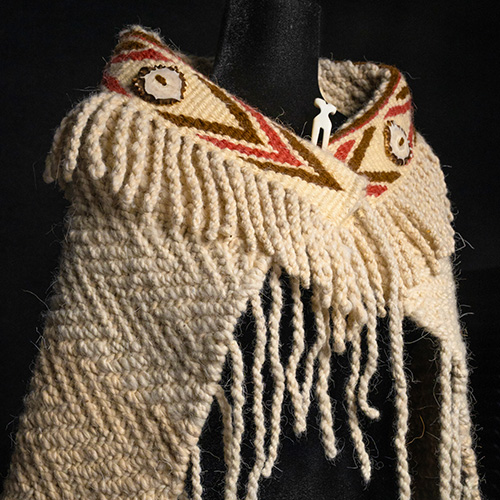For seven hours on a recent Saturday, Seattle-area high school students became working physicists.
During a UW visit, 10 high school physics students analyzed actual data from the Large Hadron Collider at the European Laboratory for Particle Physics (CERN) in Switzerland, the world’s largest and highest-energy particle accelerator. They then shared their findings with scientists at a national laboratory, who asked probing questions via videoconference.
“We want high school students to meet active research physicists, to learn what it is like to do science,” says Kris Whelan, a national staff teacher for QuarkNet, which organized the recent UW visit. QuarkNet is a National Science Foundation and Department of Energy-funded program that provides ongoing support for high school physics teachers and research opportunities for their students. “We want students to get a taste of modern physics, which is often not taught in high school,” explains Whelan, adding that the average high school physics course does not include discoveries beyond the early 20th century.

Shih-Chien Hsu, UW professor of physics and a volunteer mentor for the UW’s QuarkNet center, helped organize the daylong masterclass with Whelan, enlisting six UW physics undergraduate and graduate students to assist with the event.
Teachers from the two participating high schools—Ballard High School and Holy Names Academy—attended a pre-event orientation on campus and then provided their students with an introduction to basic particle physics in preparation for the masterclass. Getting students up to speed was essential, says Hsu, so they could take full advantage of the UW’s resources. “We had only one shot to engage the students,” he says, “but we knew that this one moment could change their thinking about physics and inspire them to pursue this further.”
Central to the masterclass was the analysis of data from the Large Hadron Collider (LHC). Hsu, who spends nearly half his time in Switzerland working at the LHC, explains that all data produced by the massive collider is in the public domain, available to anyone who’s interested. There’s even a manual explaining how to work with the data. “But if you try to self study without help from an expert, you’d feel frustration,” says Hsu, grossly understating the obvious.
The data provide clues to many of science’s greatest mysteries. Last year, LHC data led to the discovery of a Higgs boson, an elementary particle whose existence is a major step in understanding the most fundamental nature of the universe.
The high school participants analyzed LHC data using an interface that is visual and intuitive. The goal was to identify particles based on their behavior patterns. UW students were on hand to provide guidance and answer questions. “Even though the high school students don’t have deep knowledge in this area, they were able to identify the correct particle candidates with this tool,” says Hsu. “It seemed almost intuitive to them, based on pattern recognition.”

After analyzing data, the students discussed their results with scientists from Argonne National Laboratory via videoconference. This step was important, says Hsu, since physics research often involves scientists collaborating with colleagues across the globe via videoconference. In his own work, Hsu videoconferences “almost daily,” he says.
The students also toured UW physics laboratories and viewed demonstrations. Undergraduate Jimin Kim gave one of the tours and discussed his own research, demonstrating a cloud chamber apparatus that makes charged particles visible. “The chamber is a very simple mechanism that’s been around about 100 years, but it’s fun to show because they can actually see what’s happening,” says Kim. Other demonstrations included a drift tube muon chamber, developed for UW undergraduates in a senior lab course, and a prototype of a support tube being fabricated at the UW for the upgrade of the ATLAS pixel detector at CERN.

Even lunch was a learning opportunity as the high school students—3 male, 7 female—chatted with UW physics students about their shared interest in science and their involvement in research at the University.
All involved hope that this insider’s look at physics research will pique high school students’ interest in exploring further. “It’s crucial to show students more than the acceleration of little cars, which is the typical fare for high school physics. That’s birth control for the future of physics,” says Ballard High School physics teacher Eric Muhs, who has been involved with QuarkNet for more than a decade.
QuarkNet masterclasses are presented annually, with longer workshops offered in the summer. The UW Department of Physics is collaborating with QuarkNet on a five-day Cosmic ray workshop in August for four high school teachers and ten high school students.
“There is a way you can explain physics that is accessible, so that high school students can have an interest,” says Kim. “Physics does have its own beauty, and these programs are a great chance for them to see that.”
High school teachers interested in joining QuarkNet should contact Shih-Chien Hsu at schsu@uw.edu or Kris Whelan at kkwhelan@uw.edu. Program information can be found at quarknet.fnal.gov.
More Stories

A Healing Heart Returns
In February, the UW Symphony will perform a symphony that Coast Salish elder Vi Hilbert commissioned years ago to heal the world after the heartbreak of 9/11. The symphony was first performed by the Seattle Symphony in 2006.

Coast Salish Traditions are "Woven in Wool" at the Burke
A Burke Museum exhibit, co-curated by Coast Salish weavers and Burke curators, highlights the importance of weaving to Coast Salish communities.

Demystifying Quantum
In a physics course for non-STEM majors, Professor Miguel Morales teaches quantum mechanics without the advanced mathematics most quantum courses require.